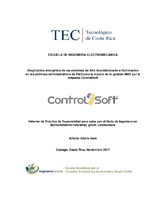Mostrar el registro sencillo del ítem
Diagnóstico energético de los sistemas de Aire Acondicionado e Iluminación en los edificios administrativos de P&G para la mejora de la gestión BMS por la empresa ControlSoft
| dc.contributor.author | Alfaro-Haro, Alfredo Alejandro | |
| dc.date.accessioned | 2018-03-07T18:26:44Z | |
| dc.date.available | 2018-03-07T18:26:44Z | |
| dc.date.issued | 2017 | |
| dc.identifier.uri | https://hdl.handle.net/2238/9640 | |
| dc.description | Proyecto de Graduación (Licenciatura en Mantenimiento Industrial) Instituto Tecnológico de Costa Rica, Escuela de Ingeniería Electromecánica, 2017. | es |
| dc.description.abstract | A building management system (BMS) is directly related to the automation of systems through communication protocols. From the point of view of energy performance, the result is an optimization of the use and consumption of energy to achieve the energy efficiency of a system. Within a responsible energy management, it is necessary an energy diagnostic tool that allows the detailed study of these systems of significant consumption, in the search for opportunities for energy conservation, the establishment of an energy baseline, and the generation of energy indicators of management, before and after an automation process. This project provides this tool, based on the study of systems of significant consumption in administrative office buildings: air conditioning and lighting, from the point of view of energy performance taking into account environmental aspects (Montreal Protocol and Kyoto) and sustainability policies of the organization. As part of the diagnostic model, an initial review or first-level audit was carried out, based on an energy monitoring system by ControlSoft. Divisions were determined for the analysis of historical energy consumption, both individually and in total. building, from the point of view of energy consumption, maximum demand and the variables involved. The energy profiles of these divisions were analyzed and visits were made to the facilities for a visual inspection. The Pareto principle was applied to identify divisions of significant consumption, results for information of the organization and as a basis for future energy diagnoses. The result indicated the detailed energy diagnosis of the systems under study. The calculation of the thermal load was made for each of the building's enclosures, according to the methods proposed by ASHRAE, which determined that the total thermal load of the building is 133TR [467.74 kW] with a factor of diversity 90% The installed cooling load per facility was analyzed, based on updated plans and route in facilities. The installed cooling load was compared with the thermal load calculated in BTU / h, in each air-conditioned room. A generic methodology was established for a passive and active energy efficiency analysis, due to a change of luminaires and a lighting control, the obtaining of results is facilitated by a programmed electronic sheet. This diagnostic methodology was applied to the case under study. It was determined energy saving savings proposals applicable to the air conditioning system due to the alternative of a watercooled system, with a reduction of the kW / TR indicator by 33% with respect to the current system and a 100% reduction in the Potential Depletion Index of Ozone (PAO), a reduction of 269,880 kWh / year, a possible reduction of 186TonCO2 / year and a savings associated with $18 507 / year in energy and demand. It was reduced by 20% with respect to the maximum demand at the start of fan and coil units. A preliminary analysis was made to evaluate the feasibility of an ice bank proposal. Lighting control strategies applicable given the actual conditions of the facilities were determined, an eventual 30% reduction in energy and 20% in demand was achieved for the installed power in lighting, due to the use of natural light, as well as a 10% in energy due to nominal power cuts in strategic periods. With a reduction of 22 856 kWh / year, a possible reduction of 16 TonCO2 / year, and an associated savings of close to $2 757/ year. As a general result, it was established that the methodological model is replicable in other office buildings, from which energy management indicators are obtained, established in 4 levels (by area, by application, energy efficiency, CO2 emissions) for the implementation of the program. respective energy of the building, and Benchmarking. Likewise, tools were created to facilitate energy diagnostics in the proposed systems. | es |
| dc.description.sponsorship | ControlSoft Systems | es |
| dc.language.iso | spa | es |
| dc.publisher | Instituto Tecnológico de Costa Rica | es |
| dc.rights | acceso abierto | es |
| dc.subject | Diagnóstico | es |
| dc.subject | Monitoreo | es |
| dc.subject | Ahorro Energético | es |
| dc.subject | Iluminación | es |
| dc.subject | Eficiencia | es |
| dc.subject | Research Subject Categories::TECHNOLOGY::Electrical engineering, electronics and photonics::Electrical engineering | es |
| dc.title | Diagnóstico energético de los sistemas de Aire Acondicionado e Iluminación en los edificios administrativos de P&G para la mejora de la gestión BMS por la empresa ControlSoft | es |
| dc.type | proyecto fin de carrera | es |


